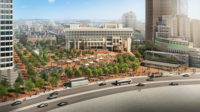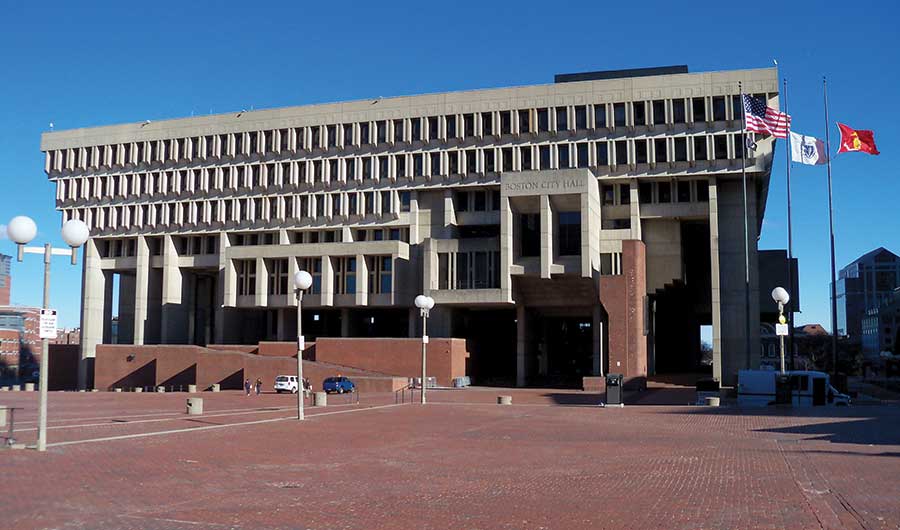More Changes Ahead for Boston City Hall

Sasaki won the commission to redesign City Hall Plaza, starting this year.
Photo © Alexius Horatius

Finegold Alexander Architects led the renovation of the City Council Chamber, which concluded in October.
Photo © Raj Das


Change is coming slowly but steadily to the landmark Boston loves to hate—Kallmann McKinnell & Knowles’s 1968 Boston City Hall. Considered a Modernist béton brut masterpiece by many but reviled by others, the building has long faced threats to its existence: In 2006, the late Mayor Thomas M. Menino proposed selling and possibly tearing down the building—an idea revived as recently as 2013 in the Boston Globe’s opinion column. Now, having escaped the wrecking ball, City Hall’s 50th anniversary has prompted Mayor Martin J. Walsh (who once argued for demolition too, as a mayoral hopeful, in 2013) to commit to an overhaul of the interiors and the large and windy seven-acre, brick-paved plaza.
So far, the city has committed $60 million to the project, and a comprehensive feasibility study published in 2017 estimates that the tab over the next quarter-century will total some $91 million. “Over these 50 years, the urban context, public safety and security measures, and municipal operations have evolved to the point that the city needs the building and plaza to adapt for 21st-century civic life,” stated the report, called Rethink City Hall.
Boston-based Utile Design took the lead on conducting the study, which identified two interior spaces that urgently needed work: the building’s main lobby, renovated by Utile in July 2017, and the City Council Chamber, refurbished last October. Utile’s redesign of the lobby vastly improves lighting in the space, which was previously dark and forebidding, and also introduces such visitor-friendly amenities as curvilinear wood benches and a coffee bar. Finegold Alexander Architects, another local firm, was tapped to refresh the City Council Chamber.
“It was depressing to see how the building had degenerated over the years,” says firm senior principal Jim Alexander. The room had poor lighting and acoustics; the seating area for City Council members was awkwardly sunk 2 feet into the floor; and, most significantly, the space lacked proper ADA accessibility.
Alexander likens the chamber to an ancient Greek agora—a civic meeting place rife with symbolism. “With the sunken seating, there was a lack of intimacy between the lawmakers and the people,” he says. “It needed to be both an intimate and participatory space. It also needed to regain its original power.”
The council seating is now flush with the rest of the floor. The City Council president’s podium and the citizens’ are more accessible and adjustable, to accommodate seated and standing speakers. The room’s coffered ceiling features LED lighting along the perimeter of each panel, and the architects introduced new materials, including wood and bronze on the tables and in the railings, “as a counterpoint to all of the cast-in-place concrete,” Alexander says. Blue drapery in the room both adds color and performs acoustically.
By chance, as he was working on the chamber, Alexander ran into Michael McKinnell—one of the building’s original architects. “I was feeling a little intimidated when explaining our role,” Alexander says. “Then he said, ‘What a relief you’re doing that!’ ”
The exterior plaza will be a bit more challenging to adapt to modern needs. According to the Rethink City Hall report, the renewed exterior space should “return to its rightful place at the forefront of urban activity” and “serve as a site of vibrant public engagement with government.” Historically, the plaza has hosted both contentious and triumphant gatherings, from protests in the 1970s over public school–desegregation busing, to present-day celebrations of the Red Sox World Series wins.
The city issued a request for qualifications in early 2018 for the plaza renovation, selecting Sasaki Associates of Watertown, Massachusetts, in May 2018. Sasaki’s plans have not been released, and the firm declined to comment for this article, but the city has indicated construction is expected to begin this year.
Phase I of the master plan calls for completion of the plaza’s southern end by 2020, with its northern portion to follow by 2022. Other high-priority repairs to the building—such as replacing aging mechanical, electrical, and plumbing fixtures—are set to be completed within this time frame too.
For all its controversial history, City Hall holds a certain deep, if paradoxical, place in the hearts of Bostonians. “We have a love/hate relationship with the building,” says Alexander. “But it’s great to see that it has finally turned the corner.”




